The global vacuum self-priming mobile pumping station market is valued at USD 37.5 million in 2025 and is set to reach USD 44.8 million by 2035, recording an absolute increase of USD 7.3 million over the forecast period. This translates into a total growth of 19.5%, with the market forecast to expand at a compound annual growth rate (CAGR) of 1.8% between 2025 and 2035. The overall market size is expected to grow by approximately 1.2X during the same period, supported by increasing demand for emergency water management solutions, growing infrastructure development projects, and rising requirements for efficient flood control systems across municipal, agricultural, industrial, and construction sectors.
The global vacuum self-priming mobile pumping station market represents a specialized segment within the water management and pumping equipment industry, driven by increasing need for portable and efficient water handling solutions in emergency situations and temporary applications. Vacuum self-priming mobile pumping stations are engineered to handle water removal tasks in challenging environments where traditional pumping systems may face operational limitations. These units combine the advantages of self-priming capabilities with mobile deployment flexibility, making them essential equipment for flood response, dewatering operations, and temporary water management applications.
The market encompasses various technological approaches to vacuum self-priming operations, including diesel-driven and electric-powered systems, each designed to meet specific operational requirements and deployment scenarios. Modern vacuum self-priming mobile pumping stations incorporate advanced control systems, high-efficiency pumps, and robust construction materials that enable reliable performance in demanding field conditions. The integration of remote monitoring capabilities, automated operation features, and enhanced portability designs has further enhanced the appeal of these specialized pumping systems among professional users and emergency response organizations.
Market dynamics are significantly influenced by increasing frequency of extreme weather events, urban development pressures that create flood-prone areas, and growing emphasis on infrastructure resilience planning. The construction industry's expansion and the associated need for effective dewatering solutions during building projects has created substantial demand for mobile pumping stations. Additionally, the growing focus on agricultural water management and the need for flexible irrigation and drainage solutions has amplified market growth opportunities across rural and agricultural applications.
User purchasing patterns show a marked preference for versatile pumping stations that combine high pumping capacity with reliable self-priming performance, mobility features, and operational flexibility. The market has witnessed significant technological advancement in pump efficiency, fuel consumption optimization, and ease of deployment, making these systems more suitable for extended operations across diverse environmental conditions.
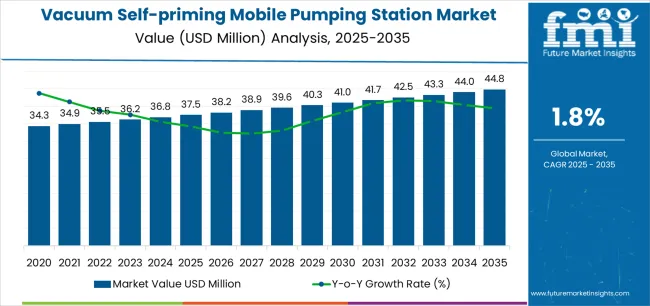
Between 2025 and 2030, the vacuum self-priming mobile pumping station market is projected to expand from USD 37.5 million to USD 40.9 million, resulting in a value increase of USD 3.4 million, which represents 46.6% of the total forecast growth for the decade. This phase of development will be shaped by increasing infrastructure development projects, rising demand for emergency response equipment, and growing adoption of mobile water management solutions across municipal flood control applications and industrial dewatering operations.
Between 2030 and 2035, the market is forecast to grow from USD 40.9 million to USD 44.8 million, adding another USD 3.9 million, which constitutes 53.4% of the overall ten-year expansion. This period is expected to be characterized by the advancement of smart pumping technologies, the development of more efficient hybrid power systems, and the expansion of automated remote monitoring capabilities across diverse emergency response and construction applications. The growing emphasis on climate resilience and proactive flood management will drive demand for advanced mobile pumping varieties with enhanced operational reliability, improved fuel efficiency characteristics, and superior remote control performance profiles.
Between 2020 and 2024, the vacuum self-priming mobile pumping station market experienced steady growth, driven by increasing awareness of flood management requirements and growing recognition of mobile pumping solutions' effectiveness in emergency response applications. The market developed as users recognized the operational advantages of self-priming technology combined with mobile deployment capabilities for addressing temporary water management challenges across various industrial and municipal applications. Technological advancement in pump design and control systems began emphasizing the critical importance of operational reliability while enhancing deployment efficiency and improving user experience across diverse emergency response and construction applications.
| Metric | Value |
|---|---|
| Estimated Value in (2025E) | USD 37.5 million |
| Forecast Value in (2035F) | USD 44.8 million |
| Forecast CAGR (2025 to 2035) | 1.8% |
From 2030 to 2035, the market is forecast to grow from USD 40.9 million to USD 44.8 million, adding another USD 3.9 million, which constitutes 53.4% of the overall ten-year expansion. This period is expected to be characterized by the advancement of IoT-enabled remote monitoring systems, the integration of predictive maintenance protocols for optimal operational scheduling, and the development of specialized pumping configurations for high-demand emergency response environments. The growing emphasis on infrastructure resilience and emergency preparedness will drive demand for premium varieties with enhanced real-time monitoring capabilities, improved fuel efficiency options, and superior automated operation characteristics.
Between 2020 and 2024, the vacuum self-priming mobile pumping station market experienced consistent growth, driven by increasing awareness of emergency water management requirements and growing recognition of mobile pumping systems' effectiveness in supporting rapid response capabilities across municipal facilities and industrial dewatering applications. The market developed as users recognized the potential for specialized mobile pumping solutions to deliver operational advantages while meeting modern requirements for reliable emergency response and efficient temporary water management performance. Technological advancement in self-priming pump technology and mobile deployment systems began emphasizing the critical importance of maintaining operational reliability while extending service intervals and improving user satisfaction across diverse emergency response applications.
Market expansion is being supported by the increasing global need for rapid-deployment water management solutions and the corresponding shift toward high-performance mobile pumping systems that can provide superior emergency response characteristics while meeting user requirements for reliable temporary water handling and cost-effective deployment solutions. Modern users are increasingly focused on incorporating pumping systems that can enhance emergency preparedness while satisfying demands for consistent, rapidly deployable water management capabilities and optimized operational efficiency practices. Vacuum self-priming mobile pumping stations' proven ability to deliver rapid deployment excellence, emergency response reliability, and diverse application possibilities makes them essential components for emergency management professionals and infrastructure maintenance organizations.
The growing emphasis on climate resilience and flood management optimization is driving demand for high-performance mobile pumping systems that can support distinctive emergency response outcomes and comprehensive water management capabilities across infrastructure projects, emergency response applications, and municipal flood control developments. User preference for pumping equipment that combines functional excellence with deployment flexibility is creating opportunities for innovative implementations in both traditional and emerging emergency response applications. The rising influence of smart monitoring technologies and advanced control systems is also contributing to increased adoption of specialized mobile pumping solutions that can provide authentic operational benefits and reliable performance monitoring characteristics.
The market is segmented by type, application, capacity, power source, and region. By type, the market is divided into diesel driven type and electric type. Based on application, the market is categorized into municipal flood control, agriculture and water conservancy, industry and mining, building construction, and others. By capacity, the market includes small capacity (up to 500 GPM), medium capacity (500-1500 GPM), large capacity (1500-3000 GPM), and high capacity (above 3000 GPM). By power source, the market encompasses diesel engine, electric motor, and hybrid systems. Regionally, the market is divided into North America, Europe, Asia Pacific, Latin America, Middle East & Africa, and other regions.
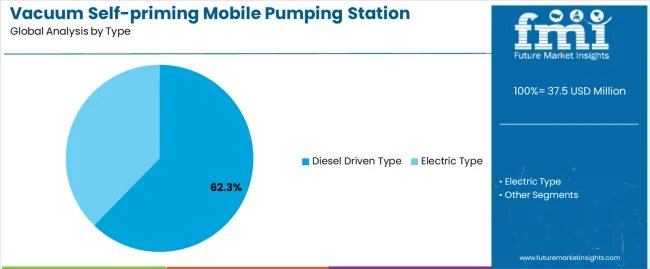
The diesel driven type segment is projected to account for 62.3% of the vacuum self-priming mobile pumping station market in 2025, reaffirming its position as the leading type category. Emergency response professionals and water management operators increasingly utilize diesel-driven systems for their superior operational independence, established reliability standards, and essential functionality in remote applications across multiple deployment scenarios. Diesel-driven pumping stations' proven performance characteristics and established fuel availability directly address user requirements for reliable emergency response and optimal deployment flexibility in municipal and industrial applications.
This type segment forms the foundation of modern emergency pumping performance patterns, as it represents the technology category with the greatest operational independence potential and established compatibility across multiple emergency response systems. User investments in diesel technology and performance optimization continue to strengthen adoption among professional emergency response organizations. With users prioritizing deployment flexibility and operational reliability, diesel-driven systems align with both emergency response objectives and performance requirements, making them the central component of comprehensive emergency water management strategies.
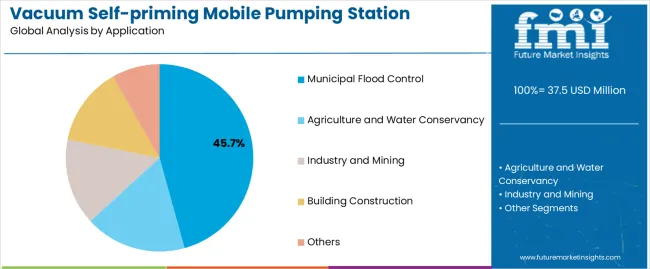
Municipal flood control is projected to represent 45.7% of the vacuum self-priming mobile pumping station market in 2025, underscoring its critical role as the primary application for emergency management organizations seeking superior flood response benefits and enhanced municipal water management capabilities. Municipal users and emergency response professionals prefer flood control applications for their established emergency response requirements, proven operational demand, and ability to maintain exceptional water management performance while supporting versatile deployment capabilities during diverse emergency situations. Positioned as essential applications for emergency-prepared municipalities, flood control offerings provide both response excellence and community protection advantages.
The segment is supported by continuous improvement in emergency response technology and the widespread availability of established flood management standards that enable response assurance and premium positioning at the municipal level. Additionally, municipal users are optimizing pumping station selections to support area-specific applications and comprehensive flood management strategies. As emergency response technology continues to advance and municipalities seek efficient flood protection methods, municipal flood control applications will continue to drive market growth while supporting community safety and emergency management strategies.
The vacuum self-priming mobile pumping station market is advancing steadily due to increasing emergency preparedness requirements and growing need for specialized mobile water management solutions that emphasize superior deployment performance across municipal segments and emergency response applications. The market faces challenges, including competition from permanent pumping installations, maintenance complexity considerations, and initial equipment cost factors affecting adoption rates. Innovation in remote monitoring integration and advanced pump technologies continues to influence market development and expansion patterns.
The growing adoption of vacuum self-priming mobile pumping stations with remote monitoring capabilities and advanced control integration is enabling users to develop water management strategies that provide distinctive operational benefits while commanding automated monitoring and enhanced real-time performance analysis characteristics. Remote monitoring applications provide superior control consistency while allowing more sophisticated operational optimization features across various emergency response categories. Users are increasingly recognizing the operational advantages of connected technology positioning for comprehensive emergency response outcomes and technology-integrated water management operations.
Modern vacuum self-priming mobile pumping station manufacturers are incorporating advanced hybrid power systems, energy efficiency technologies, and automated fuel management systems to enhance operational precision, improve deployment effectiveness, and meet user demands for efficient emergency response solutions. These systems improve operational effectiveness while enabling new applications, including extended operation programs and automated maintenance protocols. Advanced power integration also allows users to support proactive emergency preparedness positioning and performance assurance beyond traditional pumping operations.
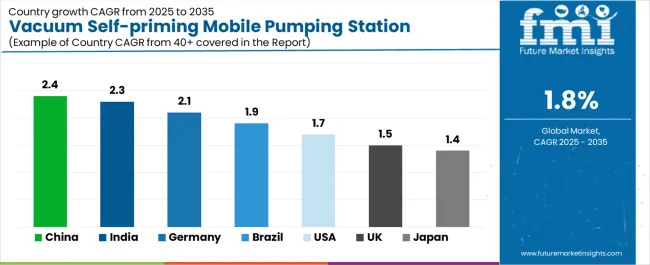
| Country | CAGR (2025-2035) |
|---|---|
| China | 2.4% |
| India | 2.3% |
| Germany | 2.1% |
| Brazil | 1.9% |
| USA | 1.7% |
| UK | 1.5% |
| Japan | 1.4% |
The vacuum self-priming mobile pumping station market is experiencing steady growth globally, with China leading at a 2.4% CAGR through 2035, driven by the expanding infrastructure development, growing emergency management requirements, and increasing adoption of advanced mobile pumping systems. India follows at 2.3%, supported by rising urbanization, expanding flood management infrastructure, and growing acceptance of emergency response technologies. Germany shows growth at 2.1%, emphasizing established infrastructure standards and comprehensive water management technology development. Brazil records 1.9%, focusing on flood management and emergency preparedness growth. The USA demonstrates 1.7% growth, prioritizing advanced emergency response technologies and infrastructure resilience.
The report covers an in-depth analysis of 40+ countries, the top-performing countries are highlighted below.
Revenue from vacuum self-priming mobile pumping station consumption and sales in China is projected to exhibit strong growth with a CAGR of 2.4% through 2035, driven by the country's rapidly expanding infrastructure development, favorable government policies toward flood management improvement, and initiatives promoting emergency preparedness technologies across major urban regions. China's position as a leading infrastructure development hub and increasing focus on emergency management systems are creating substantial demand for high-quality vacuum self-priming mobile pumping stations in both domestic and industrial markets. Major equipment companies and emergency response distributors are establishing comprehensive pumping capabilities to serve growing demand and emerging infrastructure development opportunities.
Revenue from vacuum self-priming mobile pumping station products in India is expanding at a CAGR of 2.3%, supported by rising urbanization investment, growing flood management consciousness, and expanding emergency response distributor capabilities. The country's developing urban infrastructure and increasing government investment in flood protection technologies are driving demand for vacuum self-priming mobile pumping stations across both traditional and modern municipal applications. International equipment companies and domestic distributors are establishing comprehensive operational networks to address growing market demand for emergency response devices and efficient flood management solutions.
Revenue from vacuum self-priming mobile pumping station products in Germany is projected to grow at a CAGR of 2.1% through 2035, supported by the country's mature engineering standards, established emergency response regulations, and leadership in water management technology. Germany's sophisticated infrastructure standards and strong support for advanced emergency response systems are creating steady demand for both traditional and innovative vacuum self-priming mobile varieties. Leading equipment manufacturers and specialty distributors are establishing comprehensive operational strategies to serve both domestic markets and growing export opportunities.
Revenue from vacuum self-priming mobile pumping station products in Brazil is projected to grow at a CAGR of 1.9% through 2035, driven by the country's emphasis on flood management development, emergency preparedness growth, and growing equipment distributor capabilities. Brazilian municipalities and emergency response users consistently seek reliable equipment that enhances flood management capabilities and supports emergency response excellence for both traditional and modern infrastructure applications. The country's position as a Latin American emergency management leader continues to drive innovation in specialized mobile pumping applications and emergency response standards.
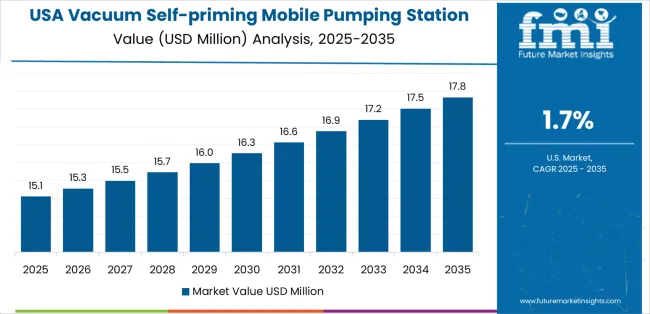
Revenue from vacuum self-priming mobile pumping station products in the USA is projected to grow at a CAGR of 1.7% through 2035, supported by the country's emphasis on emergency response technology advancement, infrastructure resilience optimization, and advanced monitoring integration requiring efficient mobile pumping solutions. American emergency management users and infrastructure professionals prioritize performance reliability and response precision, making specialized vacuum self-priming mobile pumping stations essential components for both traditional and modern emergency response applications. The country's comprehensive emergency management leadership and advancing infrastructure patterns support continued market expansion.
Revenue from vacuum self-priming mobile pumping station products in the UK is projected to grow at a CAGR of 1.5% through 2035, supported by established emergency response standards, mature municipal markets, and emphasis on flood management reliability across municipal and industrial sectors. British emergency management users and infrastructure professionals prioritize quality performance and response consistency, creating steady demand for premium mobile pumping solutions. The country's comprehensive market maturity and established emergency response practices support continued development in specialized applications.
Revenue from vacuum self-priming mobile pumping station products in Japan is projected to grow at a CAGR of 1.4% through 2035, supported by the country's emphasis on precision manufacturing, emergency excellence, and advanced technology integration requiring efficient mobile pumping solutions. Japanese emergency management users and infrastructure professionals prioritize technical performance and manufacturing precision, making specialized vacuum self-priming mobile pumping stations essential components for both traditional and modern emergency response applications. The country's comprehensive emergency leadership and advancing infrastructure patterns support continued market expansion.
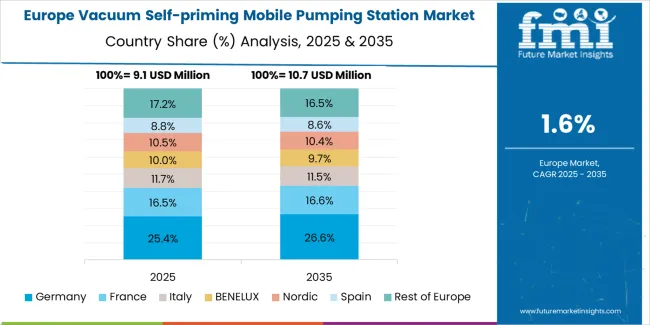
The Europe vacuum self-priming mobile pumping station market is projected to grow from USD 11.2 million in 2025 to USD 13.4 million by 2035, recording a CAGR of 1.8% over the forecast period. Germany leads the region with a 38.4% share in 2025, moderating slightly to 37.9% by 2035, supported by its strong engineering regulations and demand for premium, technologically advanced mobile pumping solutions. The United Kingdom follows with 26.8% in 2025, easing to 26.2% by 2035, driven by a mature emergency management market and emphasis on flood control reliability and operational performance. France accounts for 14.3% in 2025, rising to 14.9% by 2035, reflecting steady adoption of emergency response technologies and infrastructure enhancement.
Italy holds 10.7% in 2025, expanding to 11.4% by 2035 as emergency preparedness and specialty infrastructure applications grow. Spain contributes 6.2% in 2025, growing to 6.8% by 2035, supported by expanding flood management development and emergency awareness modernization. The Nordic countries rise from 2.4% in 2025 to 2.6% by 2035 on the back of strong environmental consciousness and advanced emergency management methodologies. BENELUX remains at 1.2% share across both 2025 and 2035, reflecting mature, infrastructure-focused markets.
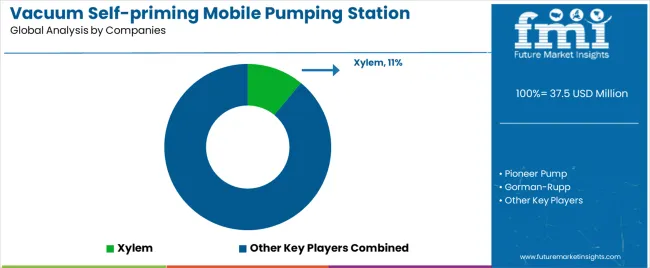
The vacuum self-priming mobile pumping station market is characterized by competition among established pump manufacturers, specialized emergency response equipment companies, and integrated water management technology providers. Companies are investing in advanced pump technologies, specialized mobile deployment systems, product innovation capabilities, and comprehensive distribution networks to deliver consistent, high-quality, and reliable vacuum self-priming mobile pumping solutions. Innovation in deployment efficiency, pump performance optimization, and emergency-focused product development is central to strengthening market position and customer satisfaction.
Xylem leads the market with 11% share with a strong focus on water technology innovation and comprehensive mobile pumping solutions, offering municipal and industrial systems with emphasis on performance excellence and technological heritage. Pioneer Pump provides specialized pumping equipment with a focus on North American market applications and engineering networks. Gorman-Rupp delivers integrated pump technology solutions with a focus on emergency response positioning and operational efficiency. Viesse Pompe specializes in comprehensive mobile pumping systems with an emphasis on European applications. Varisco focuses on comprehensive industrial pumping with advanced design and premium positioning capabilities.
The success of vacuum self-priming mobile pumping stations in meeting emergency management demands, municipal flood control requirements, and infrastructure resilience integration will not only enhance emergency response outcomes but also strengthen global water management technology manufacturing capabilities. It will consolidate emerging regions' positions as hubs for efficient emergency equipment production and align advanced economies with comprehensive infrastructure systems. This calls for a concerted effort by all stakeholders -- governments, industry bodies, manufacturers, distributors, and investors. Each can be a crucial enabler in preparing the market for its next phase of growth.
How Governments Could Spur Local Production and Adoption?
How Industry Bodies Could Support Market Development?
How Distributors and Emergency Management Industry Players Could Strengthen the Ecosystem?
How Manufacturers Could Navigate the Shift?
| Items | Values |
|---|---|
| Quantitative Units (2025) | USD 37.5 million |
| Type | Diesel Driven Type, Electric Type |
| Application | Municipal Flood Control, Agriculture and Water Conservancy, Industry and Mining, Building Construction, Others |
| Capacity | Small Capacity (up to 500 GPM), Medium Capacity (500-1500 GPM), Large Capacity (1500-3000 GPM), High Capacity (above 3000 GPM) |
| Power Source | Diesel Engine, Electric Motor, Hybrid Systems |
| Regions Covered | North America, Europe, Asia Pacific, Latin America, Middle East & Africa, Other Regions |
| Countries Covered | China, India, Germany, Brazil, United States, United Kingdom, Japan, and 40+ countries |
| Key Companies Profiled | Xylem, Pioneer Pump, Gorman-Rupp, Viesse Pompe, Varisco, and other leading vacuum self-priming mobile pumping station companies |
| Additional Attributes | Dollar sales by type, application, capacity, power source, and region; regional demand trends, competitive landscape, technological advancements in mobile pumping engineering, deployment efficiency initiatives, emergency response enhancement programs, and premium product development strategies |
The global vacuum self-priming mobile pumping station market is estimated to be valued at USD 37.5 million in 2025.
The market size for the vacuum self-priming mobile pumping station market is projected to reach USD 44.8 million by 2035.
The vacuum self-priming mobile pumping station market is expected to grow at a 1.8% CAGR between 2025 and 2035.
The key product types in vacuum self-priming mobile pumping station market are diesel driven type and electric type.
In terms of application, municipal flood control segment to command 45.7% share in the vacuum self-priming mobile pumping station market in 2025.






Full Research Suite comprises of:
Market outlook & trends analysis
Interviews & case studies
Strategic recommendations
Vendor profiles & capabilities analysis
5-year forecasts
8 regions and 60+ country-level data splits
Market segment data splits
12 months of continuous data updates
DELIVERED AS:
PDF EXCEL ONLINE
Vacuum Skin Packaging Market Size and Share Forecast Outlook 2025 to 2035
Vacuum-Refill Units Market Analysis - Size and Share Forecast Outlook 2025 to 2035
Vacuum Leak Detectors Market Size and Share Forecast Outlook 2025 to 2035
Vacuum Insulation Panels Market Size and Share Forecast Outlook 2025 to 2035
Vacuum Pressure Encapsulated Transformer Market Size and Share Forecast Outlook 2025 to 2035
Vacuum Insulated Medium Voltage Switchgear Market Size and Share Forecast Outlook 2025 to 2035
Vacuum Rated Motors Market Size and Share Forecast Outlook 2025 to 2035
Vacuum Concentrators Market Size and Share Forecast Outlook 2025 to 2035
Vacuum Insulated Low Voltage Commercial Switchgear Market Size and Share Forecast Outlook 2025 to 2035
Vacuum Pressure Impregnated (VPI) Transformer Market Size and Share Forecast Outlook 2025 to 2035
Vacuum Insulated Pipe Market Size and Share Forecast Outlook 2025 to 2035
Vacuum Therapy Devices Market Size and Share Forecast Outlook 2025 to 2035
Vacuum Pressure Swing Adsorption Market Size and Share Forecast Outlook 2025 to 2035
Vacuum Grease Market Size and Share Forecast Outlook 2025 to 2035
Vacuum Truck Market Size and Share Forecast Outlook 2025 to 2035
Vacuum Thermoformed Packaging Market Size and Share Forecast Outlook 2025 to 2035
Vacuum Insulated Switchgear Market Size and Share Forecast Outlook 2025 to 2035
Vacuum Sealing Machine Market Size and Share Forecast Outlook 2025 to 2035
Vacuum Chamber Pouches Market Size and Share Forecast Outlook 2025 to 2035
Vacuum-Sealed Packaging Market Size, Share & Forecast 2025 to 2035

Thank you!
You will receive an email from our Business Development Manager. Please be sure to check your SPAM/JUNK folder too.
Chat With
MaRIA